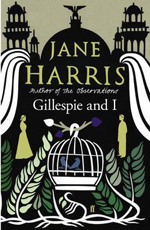
Gillespie and I is a book that refuses to be easily categorized. Part psychological thriller, part murder mystery, and part Victorian Gothic, Harris's second novel joins the ranks of similar hybridized neo-classics, such as The Crimson Petal and the White and Fingersmith. The plot propels the reader through a series of subtle twists and turns, and when the end is reached at last, instead of neatly tying up loose ends, it left me scratching my head, wondering what had just happened and turning back the pages to read more closely—which is, I suspect, precisely what Harris intended.
Spinster Harriet Baxter narrates the story in two alternating time frames: the present day (1933), and the period from her first acquaintance with the artist Ned Gillespie to the conclusion of the tragic events that befell his family (1888-90). In her brief introduction, Harriet claims that her purpose is to write a biography of her dear friend, a brilliant emerging artist who destroyed most of his paintings before taking his own life at the age of thirty-six. But is there something more self-interested, perhaps even sinister, behind her story?
Long fettered by the responsibility of caring for a dying aunt whose death left her with both freedom and a sizeable inheritance at the age of 35, Londoner Harriet decides to travel, and her first destination is Glasgow, where the International Exhibition is underway. As she explores the city, she rushes to the aid a woman who has apparently fainted but soon begins to turn blue. The grateful woman and her daughter-in-law, who happen to live not far from Harriet's lodgings, invite her to tea, and a friendship begins. Soon after, she meets Elspeth's son Ned, an aspiring painter. Coincidentally, the two have met before, although names were not exchanged: Ned had come to her defense when she was rudely treated by a docent at a London gallery. Before long, Harriet's kindness, practicality, and generosity make her indispensible to the struggling painter, his wife, Annie, and their daughters, Sibyl and Rose. Sibyl, a sullen, troubled little girl, becomes a particular trial for the family as her misbehavior turns from annoying to disturbing and dangerous.
More than forty years later, the elderly Harriet recounts the growing despair and the tragic events that at first brought her closer to the Gillespies but ultimately drove them apart. In the alternating sections set in 1933, she determines to solve the mystery of Sarah, her hired companion, a woman who reveals little of her past. Her references from the employment agency, while good, also lack detail, and when Harriet contacts one of her former employers, the woman confirms her praise but refuses to reveal why Sarah left. Why doesn't Sarah ever ask for a day off or mention any friends or family? And why, even in the midst of summer, is she covered up from neck to hand and foot?
Harris's fine prose reconstructs the world of late nineteenth-century Glasgow in atmospheric detail; here, for example, is Harriet's description of the end of a disastrous New Year's "Hogmanay" celebration:
If this review seems somewhat vague, it is deliberately so: Gillespie and I is the kind of carefully wrought story
that a reader needs to unfold for herself, and to go beyond setting the groundwork would spoil the fun. Harris has created
a set of fascinating, authentic characters caught in a complex chain of events, and she manages to leave her readers
with yet another mystery to solve in the end. It's rare to find a book so engaging that it begs one to read it
again—immediately.

Faber & Faber, paperback, 9780571238279
